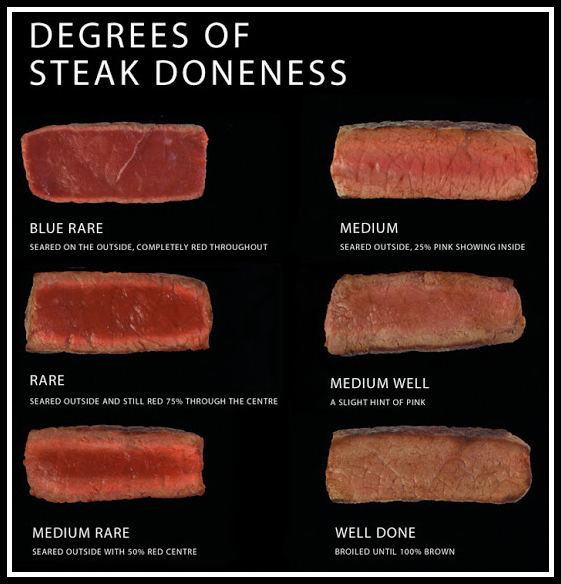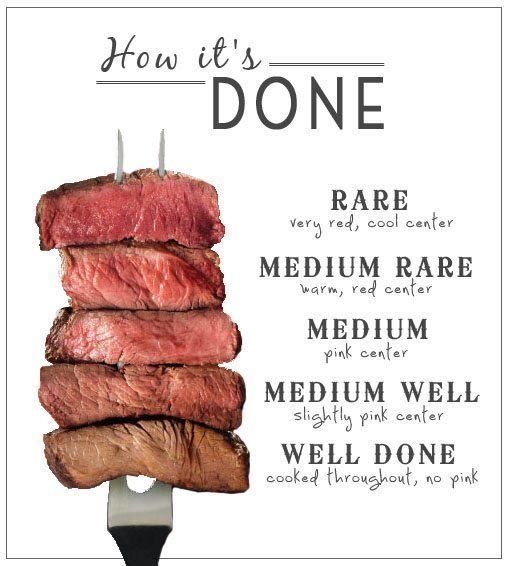 | ||
Similar Steak, Black pepper, Beef, Table salt, Onion | ||
Doneness is a gauge of how thoroughly cooked a cut of meat is based on the color, juiciness and internal temperature when cooked. The gradations of cooking are most often used in reference to beef (especially steak and roasts) but are also applicable to lamb, pork, poultry, veal and seafood (especially fish).
Contents

Gradations, their description, and the associated temperature ranges vary regionally from cuisine to cuisine and in local practice and terminology. For steaks, common gradations include rare, medium rare, medium, medium well and well done.

Easy way to check meat for doneness
Temperature

In lieu of gradations and ranges, the United States Department of Agriculture recommends a temperature of at least 63 °C (145 °F) for beef, veal, lamb steaks and roasts in order to prevent foodborne illness.
The table below is from an American reference book and pertains to beef and lamb.

The interior of a cut of meat will still increase in temperature 3–5 °C (5–10 °F) after it is removed from an oven or other heat source. The meat should be allowed to "rest" for a suitable amount of time (depending on the size of the cut or steak) before being served, which makes the meat easier to carve and its structure firmer and more resistant to deformation; its water-holding capacity also increases and less liquid is lost from the meat during carving. The whole meat and the center will also continue to cook slightly as the hot exterior continues to warm the comparatively cooler interior. The exception is if the meat has been prepared in a sous-vide process, as it will already be at temperature equilibrium. The temperatures indicated above are the peak temperature in the cooking process, so the meat should be removed from the heat source a few degrees cooler.
Color

As meat is cooked, it turns from red to pink to gray to brown to black (if burnt), and the amount of red liquid, myoglobin (not blood), and other juices decreases. The color change is due to changes in the oxidation of the iron atom of the heme group in the myoglobin protein: raw meat is red due to myoglobin protein in the muscles, not hemoglobin from blood (which also contains a heme group, hence the color). Prior to cooking, the iron atom is in a +2 oxidation state, and bound to a dioxygen molecule (O2), with a red color. As cooking proceeds, it loses an electron, moving to a +3 oxidation state, and coordinating with a water molecule (H2O), turning brown in the process.

Searing raises the meat’s surface temperature to 150 °C (302 °F), yielding browning via different reactions: caramelization of sugars, and the Maillard reaction of amino acids. Raised to a high enough temperature, meat blackens from burning.
Drying
Well done cuts, in addition to being brown, are drier and contain few or no juices. Note that searing (cooking the exterior at a high temperature) in no way "seals in the juices" – water evaporates at the same or higher rates as unseared meat. Searing does play an important role, however, in browning, a crucial contributor to flavor and texture.
